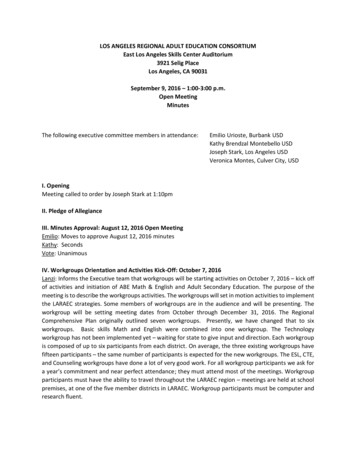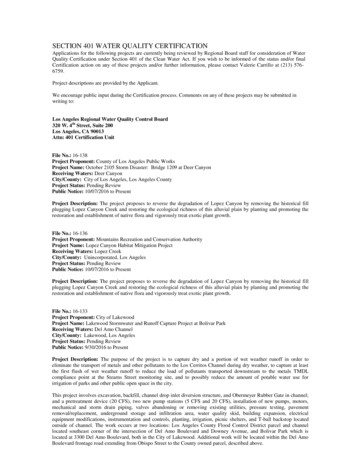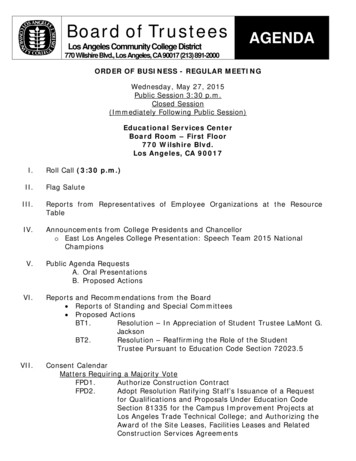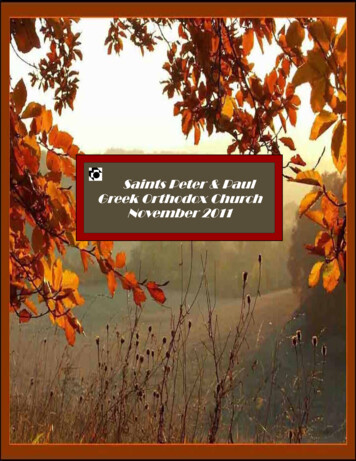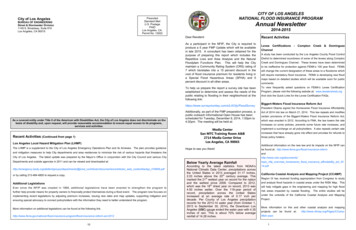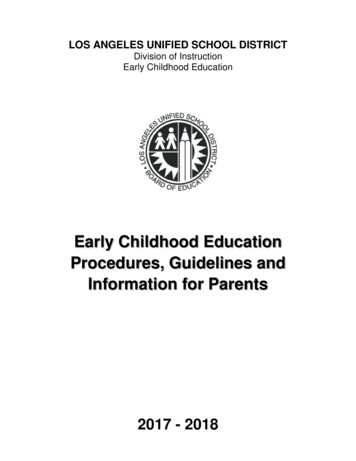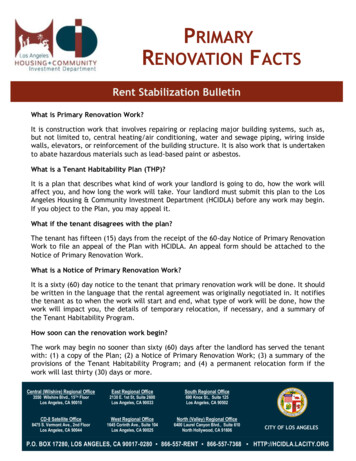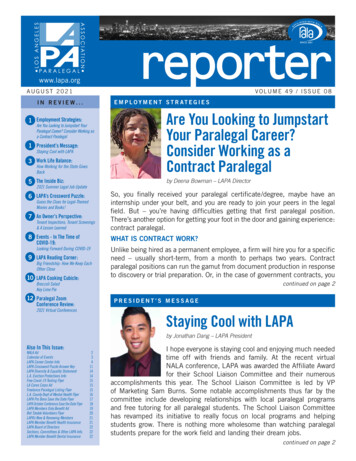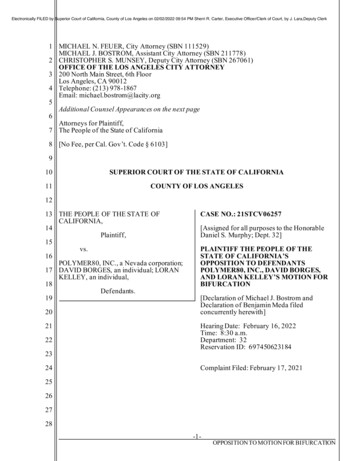
Transcription
Electronically FILED by Superior Court of California, County of Los Angeles on 02/02/2022 09:54 PM Sherri R. Carter, Executive Officer/Clerk of Court, by J. Lara,Deputy Clerk1 MICHAEL N. FEUER, City Attorney (SBN 111529)MICHAEL J. BOSTROM, Assistant City Attorney (SBN 211778)2 CHRISTOPHER S. MUNSEY, Deputy City Attorney (SBN 267061)OFFICE OF THE LOS ANGELES CITY ATTORNEY3 200 North Main Street, 6th FloorLos Angeles, CA 900124 Telephone: (213) 978-1867Email: michael.bostrom@lacity.org5Additional Counsel Appearances on the next page6Attorneys for Plaintiff,7 The People of the State of California8 [No Fee, per Cal. Gov t. Code § 6103]910SUPERIOR COURT OF THE STATE OF CALIFORNIA11COUNTY OF LOS ANGELES1213 THE PEOPLE OF THE STATE OFCALIFORNIA,14Plaintiff,15vs.16POLYMER80, INC., a Nevada corporation;17 DAVID BORGES, an individual; LORANKELLEY, an individual,18Defendants.192021222324CASE NO.: 21STCV06257[Assigned for all purposes to the HonorableDaniel S. Murphy; Dept. 32]PLAINTIFF THE PEOPLE OF THESTATE OF CALIFORNIA SOPPOSITION TO DEFENDANTSPOLYMER80, INC., DAVID BORGES,AND LORAN KELLEY S MOTION FORBIFURCATION[Declaration of Michael J. Bostrom andDeclaration of Benjamin Meda filedconcurrently herewith]Hearing Date: February 16, 2022Time: 8:30 a.m.Department: 32Reservation ID: 697450623184Complaint Filed: February 17, 202125262728-1-OPPOSITION TO MOTION FOR BIFURCATION
1 Additional Counsel of Record:2 QUINN EMANUEL URQUHART & SULLIVAN, LLPRobert M. Schwartz (SBN 117166)3robertschwartz@quinnemanuel.comDuaneR. Lyons (SBN 125091)4duanelyons@quinnemanuel.com5 Jennifer W. Stone (SBN 331600)jennystone@quinnemanuel.com6 Andrew M. Brayton (SBN 319405)andrewbrayton@quinnemanuel.com7 865 South Figueroa Street, 10th Floor8 Los Angeles, California 90017Telephone: (213) 443-30009EVERYTOWN LAW10 Eric A. Tirschwell (admitted pro hac vice)etirschwell@everytown.org11Len Hong Kamdang (admitted pro hac vice)lkamdang@everytown.org12Mark Weiner (admitted pro hac vice)mweiner@everytown.org13450 Lexington Avenue. P.O. Box 418414 New York, NY 10017Telephone: (646) 324-82221516171819202122232425262728-2-OPPOSITION TO MOTION FOR BIFURCATION
1TABLE OF CONTENTSPage23 I.INTRODUCTION.14 II.DEFENDANTS HAVE REPEATEDLY SOUGHT TO DELAY IN ORDER TOAVOID RESPONDING TO DISCOVERY .25678910ARGUMENT .4III.LEGAL STANDARD .4IV.THE COURT SHOULD NOT BIFURCATE THE CASE.6A.Bifurcation Would Be Inefficient and Would Inconvenience Witnesses .6B.The Protective Order Sufficiently Mitigates Any Privacy Concerns RaisedBy Defendants .1011 CONCLUSION .111213141516171819202122232425262728-i-OPPOSITION TO MOTION FOR BIFURCATION
1TABLE OF AUTHORITIESPage(s)23City & Cty. of San Francisco v. Uber Techs., Inc.,36 Cal. App. 5th 66 (2019) .10, 114 City of Redlands v. Cty. of San Bernardino,96 Cal. App. 4th 398 (2002). 85,6182 Cal. App. 4th 247 (2010). 77 Estate of Young,160 Cal. App. 4th 62 (2008). 58Gionis v. Superior Court,9202 Cal. App. 3d 786 (1988).4, 510 Quechan Indian Tribe v. United States,535 F. Supp. 2d 1072 (S.D. Cal. 2008) . 811,12(US), Inc., 83 Cal. App. 4th 488, 494 . 713 Westinghouse Elec. Corp. v. Newman & Holtzinger, P.C.,39 Cal. App. 4th 1194 (1995). 51415Statutory Authorities16 Cal. Bus. & Prof. Code § 17206 . 717 Cal. Civ. Proc. Code § 598 . 4, 6, 918 Cal. Civ. Proc. Code § 1048 . 619 Cal. Civ. Proc. Code § 1048(b) . 420 Cal. Civ. Proc. Code § 3295 . 521 Cal. Civ. Code § 3480.6, 722 Gun Control Act, 18 U.S.C. § 921(a)(3). 6232425262728-ii-OPPOSITION TO MOTION FOR BIFURCATION
1I.2INTRODUCTIONAfter bringing a demurrer, an ex parte application for a stay, and a motion for judicial3 abstention, Defendants now bring the instant motion for bifurcation. Not only do Defendants ask4 this Court to conduct separate trials on liability and remedies, but they also seek to deny Plaintiff5 the right to conduct any discovery conceivably related to possible remedies until liability has been6 established. The Court should deny this ill-conceived motion, which is the latest effort in a now7 well-established pattern of attempts to deny Plaintiff valuable discovery and to delay re solution of8 this case. As set forth below, there is overlap between liability and remedies on many of the9 issues in this case and bifurcation would prejudice Plaintif f by denying it access to discovery.10 Moreover, adopting Defendants approach would unnecessarily prolong this action by many11 months. The Court would need to recess the trial after a finding of liability, allow the parties12 months to conduct discovery regarding the applicable remedies and then return for a separate trial13 on those remedies, including the scope of injunctive relief . Such an unnecessary delay would have14 real-world consequences given the urgency caused by Defendants sales of ghost guns.15While Defendants continue to stall, the ghost gun epidemic continues to explode, fueled by16 Defendants products, which are being used in massive numbers in crimes in Los Angeles and17 beyond and are directly harming and jeopardizing the safety and well-being of California citizens.18 According to recent statistics released by the Los Angeles Police Department, 1,499 people were19 shot in the City of Los Angeles in 2021, up from 1,337 in 2020, and the total number of guns20 recovered by the LAPD jumped from 6,536 in 2020 to 8,661 in 2021. 1 The number of untraceable21 ghost guns saw a similar leap from 813 recovered in 2020 to 1,921 in 2021i.e., 20% of all guns22 recovered by LAPD in 2021 were ghost guns. 2 And of those 1,921 ghost guns recovered, 1,72223 or 90%were Polymer80 products. Declaration of Benjamin Meda, ¶¶ 5, 7.2425LAPD, LA County Sheriff Find Homicides Up Again In 2021, CBS Los Angeles, Jan. 13, 202211:39 pm, available at -county-sheriff27 homicides-up-2021/.2 Id.28261-1-OPPOSITION TO MOTION FOR BIFURCATION
1The default rule in a civil proceeding is to litigate liability and remedies together.2 Defendants offer no credible explanation for an exception in this case and simply argue that3 remedies discovery (which they claim might involve three experts on undescribed topics) is too4 burdensome to conduct now and that it must wait until a finding of liability. But Defendants5 arguments are as inadequate as they are nondescript. Not only is the discovery they seek to delay6 relevant to the issue of liability, but restarting discovery after a full trial on liability would result in7 numerous inefficiencies. The parties would have to re-depose witnesses on issues and conduct8 that they were precluded from exploring during the initial discovery period. Witnesses would9 have to be re-called to the stand, and the Court would be forced to re-familiarize itself with a trial10 record that was months old.11Moreover, Defendants claim that bifurcation is necessary to protect their privacy interests12 is specious in light of the parties stipulated protective order, and Defendants failure to even13 mention the protective order (much less explain why it is inadequate) in their Motion demonstrates14 that their true purpose to is to delay their day of reckoning.15161718Accordingly, Plaintiff respectfully requests that the Court deny Defendants Motion.II.DEFENDANTS HAVE REPEATEDLY SOUGHT TO DELAY IN ORDER TOAVOID RESPONDING TO DISCOVERYOn February 17, 2021, Plaintiff sued Defendants for violations of California s Unfair19 Competition Law ( UCL ) and public nuisance statute based on their sales of Buy Build Shoot20 kits, frame kits, and receiver kits. These kits provide the purchaser with everything they need to21 manufacture a firearm or a completed frame or receiver in violation of state law. Complaint at22 ¶ 40 n.26. Plaintiff seeks an injunction prohibiting Defendants from continuing to violate23 California s UCL and public nuisance statute, monetary relief in the form of statutory penalties,24 and the creation of an abatement fund, in addition to costs and any other relief that the Court may25 deem proper. Id., Prayer for Relief, ¶¶ 1 4.26On April 20, 2021, Defendants filed a Demurrer, which the Court overruled on June 7. On27 May 7, the ATF announced proposed rule 2021R-05. On May 20, Defendants filed an ex parte28-2-OPPOSITION TO MOTION FOR BIFURCATION
1 application to stay the case pending completion of ATF s rulemaking process, which the Court2 also denied, on May 27, 2021.3Plaintiff served its first set of discovery requests on Defendants on August 6, including4 Requests for Production of Documents, Special Interrogatories, and Form Interrogatories.5 Bostrom Decl. at ¶ 1. On August 30, replacement counsel for Defendants requested a four-week6 extension to the discovery response deadline, which Plaintiff did not oppose. Id. at ¶ 2. Counsel7 filed their notice of substitution on September 8, but instead of responding to Plaintiff s discovery,8 on September 23, Defendants filed a Motion for Judicial Abstention and Dismissal or, in the9 Alternative, for a Stay, which the Court denied on November 10.10On October 8, when Defendants finally served their discovery responses, they produced no11 documents and provided no substantive responses to the interrogatories, claiming that they were12 waiting for the entry of a Protective Order and a ruling from the Court on their then-pending13 Motion for Judicial Abstention, which would not be heard for more than a month. Id. at ¶ 3, Exs.14 1, 2.15Regarding a protective order, Plaintiff first sent Defendants original counsel a draft16 protective order in April 2021, pursuant to the parties meet and confer in advance of the first case17 management conference. Id. at ¶ 4. In October 2021, after having received no response from18 Defendant s original counsel on the draft protective order, Plaintiff began negotiating the terms of19 a protective order with Defendants current counsel. Id. at ¶ 5. The parties agreed to the vast20 majority of the terms of the protective order, but Defendants refused to agree to the Los Angeles21over a22 confidentiality designation, the party asserting the designation has the burden of filing a motion.23 Id. at ¶ 6.rvention on the issue by way of an informal24 discovery conference, resulting in even more delay. Id. Following that conference, where the25 Court indicated that it would likely use the LASC model order, the parties entered into a stipulated26 protective order, which the Court signed on December 17, 2021. Id. at ¶ 7, Ex. 3.27Defendants filed the instant Motion on January 5, 2022, prior to providing any substantive28 discovery responses to Plaintiff s requests. Defendants eventually produced the first set of-3-OPPOSITION TO MOTION FOR BIFURCATION
1 documents in a series of rolling productions, responsive only to the first two of Plaintiff s2 document requests, on January 6five months after Plaintiff s original service of the requests. Id.3 at ¶ 8, Ex. 4.4Although Defendants have now responded to certain of Plaintiff s discovery requests,5 Defendants have objected to certain interrogatories based on their claim that the information6 sought is only relevant to remedies and should not be produced until Defendants have been found7 liable. Defendants have refused to respond to Plaintiff s interrogatories requesting information8 relating to the total number and percentage of sales and shipments of frame or receiver kits and9 Buy Build Shoot Kits, and have refused to produce documents sufficient to show certain financial10 information of Polymer80 and individual Defendants David Borges and Loren Kelley .3 As set11 forth below, this information is relevant to liability as well as remedies.12ARGUMENT13III.14LEGAL STANDARDThe Court may bifurcate liability and remedies when the convenience of witnesses, the15 ends of justice, or the economy and efficiency of handling the litigation would be promoted16 thereby. Cal. Code Civ. Proc. § 598. Similarly, [t]he court, in furtherance of convenience or to17 avoid prejudice, or when separate trials will be conducive to expedition and economy, may order a18 separate trial of any cause of action, including a cause of action asserted in a cross-complaint, or19 of any separate issue or of any number of causes of action or issues. Cal. Code Civ. Proc.20 § 1048(b).21Defendants offer no principled justification for the instant motion. Instead, they claim,22 without any basis for doing so, that in many types of actions bifurcation is favor[ed], and the23 party seeking it is not required to justify his request with a compelling showing of need.Mot.24 at 8 (quoting Gionis v. Superior Court, 202 Cal. App. 3d 786, 788 (1988)). That is not what25 Gionis or any other authority says. Gionis dealt with a divorce proceeding in which the husband26See Bostrom Decl. at ¶ 9, Ex. 5, Supp. Responses to Interrogatory Nos. 4, 7, and 13; Bostrom27 Decl.¶ 9, Ex. 6, Supp. Responses to Request for Production Nos. 11 and 16. Plaintiff expects tofile a motion to compel forthwith with respect to Defendants refusals to produce documents.283-4-OPPOSITION TO MOTION FOR BIFURCATION
1 wished to bifurcate the issue of marital status from the issues of custody, support and property2 division. Gionis, 202 Cal. App. 3d at 787. Because the Family Law Act and related precedent3 recognized that two parties should not be forced to remain married while unrelated and lengthy4 custody and property litigation ensued, the court concluded that [i]n light of the policies favoring5 bifurcation, the trial court was mistaken in its apparent belief that [the husband] was required to6 justify his request [to bifurcate] with a compelling showing of need. Id. at 788.7Similarly, Defendants misrepresent the law where they assert that the purpose of8 bifurcation9is to protect the legitimate privacy interests in a defendant s financial affairs,trade secrets, and other confidential proprietary information.Mot. at 9 (quoting Estate of10 Young, 160 Cal. App. 4th 62 (2008), and Westinghouse Elec. Corp. v. Newman & Holtzinger,11 P.C., 39 Cal. App. 4th 1194 (1995)). 4 In Westinghouse, the court sustained a demurrer to a12 complaint brought against former adversarial attorneys for dissemination of information that the13 plaintiff alleged was shared in violation of a secrecy agreement and protective order. 39 Cal. App.14 4th at 1197. Although the case does contain the clauses to protect the legitimate privacy15 interests and trade secrets and other confidential proprietary information, it does so in referring16 to the potential violation of the protective order, not the need to bifurcate. Id. at 1208-09. Indeed,17 Westinghouse does not diIn18 sustaining the demurrer, the Court of Appeal simply noted that a protective order promotes a19 party s interest in privacy by restricting the dissemination of discovered information, as the20 protective order does in this case. Id. at 1208. In Estate of Young, the court merely noted that one21 of the purposes of Cal. Code Civ. Proc. § 329522 to punitive damageswhich concerns discovery of information relatedis to allow a protective order for personal privacy in a defendant s23 financial affairs. 160 Cal. App. 4th at 88-89.524Defendants flatly manufacture their purported quote from Estate of Young and Westinghouse,cobbling together unrelated statements from two cases addressing different issues (neither of26 which is relevant to the bifurcation question here) to create a statement that appears in neithercase, or apparently elsewhere in California law.27 5 Defendants concede that § 3295 does not apply to this case. Mot. at 9, n.2. Indeed, that theCalifornia legislature created special procedures for the production of financial information in the28 (footnote continued)-5254OPPOSITION TO MOTION FOR BIFURCATION
1In short, Defendants citations are inapposite and do not alter the principles that bifurcation2 is the exception, not the rule, and that it is only allowed after the Court finds that the relevant3 conditions set forth in Cal. Code Civ. Proc. §§ 598 and 1048(b) are satisfied.45IV.THE COURT SHOULD NOT BIFURCATE THE CASEPlaintiff does not dispute that the Court has the ability and discretion to bifurcate issues6 when doing so would promote the economy or efficiency of litigating the case. But Defendants7 have not explained why this case merits bifurcation. Defendants are asking this Court to halt all8 discovery relating to remedies and to contemplate an additional trial based on vague and9 unsubstantiated assertions that mischaracterize the nature of Plaintiff s claims and offer only10 hypotheses as to potential inconvenience down the road, all while ignoring the entry of the11 Protective Order in this case. Their Motion should be denied.12A.13Defendants claim that Plaintiff s two causes of action boil down to a single question: doBifurcation Would Be Inefficient and Would Inconvenience Witnesses14 Polymer80 s products at issue constitute firearms ?15As an initial matter, as set forth at length in the People s Opposition to Defendant s Motion16 for Judicial Abstention, the People s claims do not all turn on the federal definition of the word17firearm in the Gun Control Act, 18 U.S.C. § 921(a)(3). The Complaint is based as much, if not18 more, on violations of California law rather than on federal law. The only two causes of action19 alleged are for violation of California s public nuisance statute, which requires no proof of20 violation of any separate federal (or state) law, California Civil Code § 3480, and for violations of21 California s Unfair Competition Law ( UCL ), which includes multiple theories of recovery22 where the federal definition of firearm is either irrelevant or only one of the ways Plaintiff has23 alleged Defendants violated the UCL. Complaint at ¶¶ 84-95. Stated differently, even if24 contrary to a plain reading of the Gun Control Act and commonsense the gun-building kits252627 context of punitive damages suggests that special procedures are not necessary in a case wherepunitive damages are not available.28-6-OPPOSITION TO MOTION FOR BIFURCATION
1 Defendants sell are ultimately found not to constitute firearms under federal law, Plaintiff can2 still prevail on multiple alternative legal theories and claims.3More broadly, bifurcation makes no sense here because the issues related to the three4 primary forms of relief overlap and are intertwined with the issues pertaining to liability in this5 case, and Plaintiff has a need to access much of the information Defendants seek to withhold now6 to support their case for liability. First, in assessing the amount of the statutory penalty under the7 UCL, the Court shall consider, the nature and seriousness of the misconduct, the number of8 violations, the persistence of the misconduct, the length of time over which the misconduct9 occurred, the willfulness of the defendant s misconduct, and the defendant s assets, liabilities, and10 net worth. Cal. Bus. & Prof. Code § 17206 (b). The nature and seriousness of Defendants11 misconduct, number of violations, persistence of misconduct, length of time over which it12 occurred, and willfulness of the misconduct are all issues that overlap at least in part with the13 question of Defendants liability.614 Defendants can be15 unscrupulous or substantially inighs16182 Cal. App. 4th17 247, 257 (2010). Plaintiff will likely introduce evidence of the scope of the total number of18 Polyer kits into California to show that19 the harm is great enough to outweigh any utility of the products. Similarly, the same evidence20 would be needed to show that Polymer80 had created a public nuisance, which is a nuisance2122n entire community or neighborhood, or any considerablemay not be examined during23 the liability phase of certain UCL claims, if plaintiff succeeds in arguing that the UCL imposesat 5-6 (emphasis added). To begin, the People need not argue that the UCL24 imposes strict liability. It doRothschild v.(US), Inc.The unfair competition law imposes strict liability25on persons who engage in conduct within its purview; to succeed on an unfair competitio n claim,26 it is not necessary to establish that the defendant intended to injure anyone.the People will likely present substantial evidence tending to prove intent in establishing that27 Defendants violated the law in the first place, and nothing in the law precludes the People fromdoing so.286-7-OPPOSITION TO MOTION FOR BIFURCATION
1Cal. Civ. Code § 3480. As to Defendants financial information, that is just2 one data point3and a point that is unlikely to be the subject of significant discovery.Second, the issues underlying Plaintiff s requested abatement fund overlap substantially4 with issues relating to liability, including the number of untraceable frame and receiver kits and5 Buy Build Shoot Kits Defendants have sold into California, whether Defendants have sold those6 kits without conducting required background checks and/or sold kits to people with felony7 convictions who could not otherwise own firearms, and whether Defendants have sold firearms8 without other safety features. Evidence of the number and nature of these sales into California is9 relevant to show the extent of the nuisance caused by Polymer80 s products as well as to explain10 the corresponding increase in investigative costs and expenditure of law enforcement resources.11 Quechan Indian Tribe v. United States, 535 F. Supp. 2d 1072, 1123 (S.D. Cal. 2008) (citing12 California law for13 substantial and unreasonable.14o qualify as a public nuisance, the nuisance must beCompl. ¶ 102.Third, the injunctive relief sought by Plaintiff is coextensive with Defendants liability and15 will not require additional evidence beyond what is needed in the liability phase. In short, the16 scope of the injunction should be the same as whatever liability Defendants are found to haveif17 Defendants are selling products that violate the law, they should be enjoined from continuing to do18 so. As explained in Plaintiff s Opposition to Defendants Motion for Judicial Abstention, once the19 Court concludes that Polymer80 s Buy Build Shoot kits and frame and receiver kits are illegal,20 Plaintiff will ask the Court to enjoin the sale of such products. No further analysis is necessary.21 Defendants argue that [i]njunctions concerning the Company s future products indubitably are22 separate from the questions of whether or not Company products currently violate the law, Mot.23 at 6, but the law is more flexible: the the court is entitled to restrain the person from committing24 similar or related unlawful activity. City of Redlands v. Cty. of San Bernardino, 96 Cal. App. 4th25 398, 416 (2002). Defendants argument does not support bifurcation. If one of Defendants26 current products at issue is being sold in violation of the UCL or is causing a public nu isance, then27 the Court can grant injunctive relief as to that product immediately upon finding liability, without28 further inquiry. If Defendants, down the line, come out with a related future product that the-8-OPPOSITION TO MOTION FOR BIFURCATION
1 People contend appropriately falls under the Court s injunction, then there may be a dispute about2 liability as to the sale of that productbut that does not provide a basis for bifurcating liability3 and remedies and all attendant discovery now.4Defendants have not established that the People s requested relief is so untethered from the5 issues relating to liability that bifurcation would promote the convenience of witnesses, the ends6 of justice, or the economy and efficiency of handling the litigation.7Cal. Code Civ. Proc. § 598.7 They argue only that the parties conceivably could call three separate experts as to the remedies8 issue and that [t]he parties will also need to exchange significant discovery concerning these9 complex topics. Mot. at 9. Notably, Defendants make no attempt to describe this expert10 testimony or to explain why it would be too burdensome to conduct prior to a non-bifurcated trial.11 This is likely because, as explained above, almost all the evidence an expert will rely on in12 calculating statutory penalties and an abatement fund will be the evidence that goes to showing13violations of the UCL and liability for creating a public nuisance, and the Court need14 only enjoin the sale of the products found to be sold in violation of the law determined at the15 liability phase.16Convenience of the witnesses also cuts strongly against bifurcation in this case. Given the17 overlap of the issues, the same witnesses will likely provide the bulk of the testimony as to both18 liability and remedies. These witnesses, including Defendants themselves, will therefore have to19 testify anyway, and Defendants proposal raises the possibility that those witnesses will have to sit20 for multiple depositions and appear for multiple days of trial testimony. With respect to the21significant discovery needed, the People are also at a loss as to how to respond to this22 conclusory argument.23In sum, Defendants are the party asking for the Court to bifurcate this action, and they24 simply have not explained why bifurcation here would satisfy any of the relevant statutory factors.2526All of the cases cited by Defendants as purportedly supporting bifurcation are distinguishable,27 including because the issues of liability and remedies in those cases do not overlap as significantlyas in this case.287-9-OPPOSITION TO MOTION FOR BIFURCATION
1B.23456789101112131415161718192021The Protective Order Sufficiently Mitigates Any Privacy Concerns Raised ByDefendantsDefendants also claim that bifurcation is necessary to protect Defendants privacy interestsin their own financial information. Mot. at 10. But, that concern has already been addressed bythis Court s entry of a Protective Order. Defendants fail to offer any credible explanation as towhy that Protective Order is insufficient to safeguard their privacy interests. See City & Cty. ofSan Francisco v. Uber Techs., Inc., 36 Cal. App. 5th 66, 83 (2019) (holding that movant seekingto reverse order requiring compliance with administrative subpoenas failed to meet its burden todemonstrate that the protective order was inadequate to protect its privacy interest).Pursuant to the Protective Order, sensitive non-public personal information, personalfinancial, credit, or banking information is treated as Highly Confidential Material if sodesignated by the producing party. 8 Bostrom Decl. at ¶ 7, Ex. 3 at ¶ 1(f)(2). If Defendants nowbelieve that the Protective Order is insufficient to protect their financial information, theappropriate recourse would be to file a motion to amend the Protective Order. See Uber Techs., 36Cal. App. 5th at 84. Instead of offering any such amendments, Defendants simply claim that theirprivacy concerns justify the extraordinary relief of bifurcating discovery pertaining to liability andremedies in this case. That Defendants did not raise concerns with the scope of the ProtectiveOrder while negotiating its terms demonstrates that Defendants privacy argument is a pretext foravoiding their discovery obligations. Moreover, Defendants failure to even acknowledge theexistence of the Protective Order in their Motion demonstrates their true intention is delay, and isl822reasonably and in good faith believes contains or will disclose: . . . sensitive non-public personal23 information, personal financial, credit, or banking information, tax returns, medical history, orInformation of an intimate nature r24 Condesigna25believes contains or will disclose confidential, personal (including home addresses, e-mail26 addresses and personal telephone numbers), proprietary financial, customer, client or sensitivecommercially sensitive information, confidential trade secrets, communications regarding any of27 the Confidential Information, information a party is contractually or legally obligated to maintainBostrom Decl. at ¶ 7, Ex.
MICHAEL N. FEUER, City Attorney (SBN 111529) MICHAEL J. BOSTROM, Assistant City Attorney (SBN 211778) CHRISTOPHER S. MUNSEY, Deputy City Attorney (SBN 267061) OFFICE OF THE LOS ANGELES CITY ATTORNEY 200 North Main Street, 6th Floor Los Angeles, CA 90012 Telephone: (213) 978-1867 Email: michael.bostrom@lacity.org


